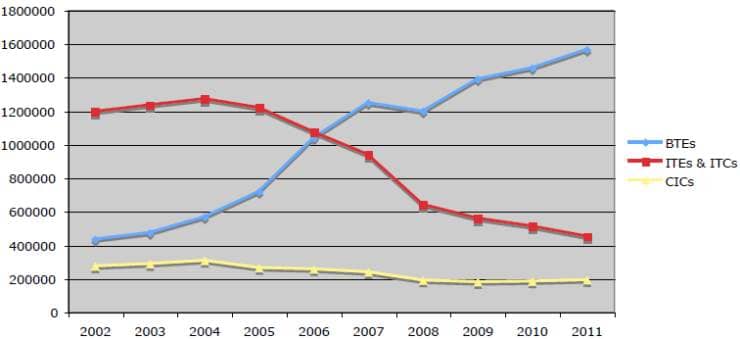
Just when you thought that in-the-ear (ITE) hearing aids couldn’t really get much smaller or “invisible” for cosmetic-conscious consumers, our industry’s product developers have come up with new ways to make them even more tiny—calling these new devices invisible-in-the-canal (IIC), micro-in-the-canal (MIC), or what might be thought of as mini-completely-in-the-canal (mini-CIC) hearing aids. Using new thin-shell technology and components that continue to follow the general miniaturization trends of Moore’s Law, it appears that these new hearing aids have a lot going for them.
But this new class of mini-CICs is certainly bucking the industry’s trend toward behind-the-ear (BTE) devices (Figure 1). In 2011, BTEs constituted 70% of all the hearing aids dispensed, while CICs made up only 7%—or about half the market share they held during the 5 years at the start of the new century (2000 to 2004) when they were essentially positioned as the premium-line digital products.
Then came the thin-tube open-fit and receiver-in-the-canal (RIC) BTE revolution, starting in 2004, that radically changed fitting recommendations relative to hearing aid styles. However, even in light of the BTE revolution, CICs have retained a relatively important niche. Indeed, a number of hearing aid manufacturers have had some head-turning successes in introducing CIC products during the past several years.

Figure 1. US net unit sales of hearing aids by styles. Although CICs fell in market share—from about 14% to 15% during 2000 to 2004, to about 7% today—CICs have been making a comeback in recent years and the latest product introductions suggest the devices may be poised for a resurgence. For a more detailed look at CICs versus other ITE styles during the past 4 years, see Figure 1 of the article by Becky Finlen, AuD.
It’s true that some dispensing professionals use CICs as “starter aids” for select patients. Many first-time users haven’t quite come to grips with their hearing loss and are extremely self-conscious about “how it will look.” So, for these first-time users, a CIC becomes a great option that provides a good combination of performance and discreteness. And, when looked at in this way, CICs have almost certainly “saved” a large number of people from walking away from the amplification they needed.
CICs also have several other potential advantages, and many of these advantages become pretty substantial when the aids are placed deep in the canal. These advantages have been written about extensively in HR, and Eric Branda, AuD, does an excellent job summarizing them in his article “Deep Canal Fittings: Advantages, Challenges, and a New Approach.” Unfortunately, deep fittings are rarely achieved due to a reluctance by professionals to “go deep” in impression taking. However, with new potential solutions to this obstacle—whether via Dr Branda’s solution or via emerging technologies such as the Lantos ear scanner (see this month’s HR Online)—deep fittings may become more practical, and we may start to see the true potential of CICs.
While I’m not saying that CIC sales will skyrocket to rival BTE market share, there are enough interesting innovations relative to impression-taking/scanning, product enhancements, and acoustic advantages that may give our smallest hearing aid style a comeback, of sorts, in popularity—among both consumers and hearing care professionals.
Karl Strom
Editor-in-Chief




